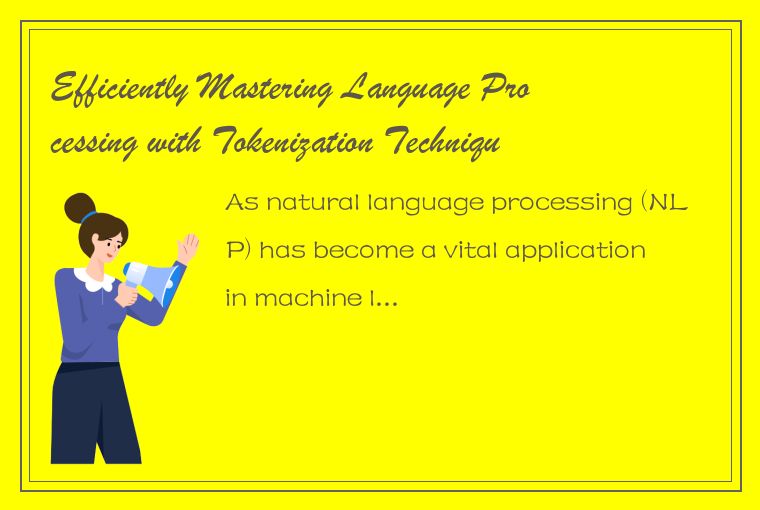As natural language processing (NLP) has become a vital application in machine learning, text analytics, and other fields, the need for efficient language processing methodologies has increased. Tokenization, a fundamental technique for segmenting text into individual tokens, plays an essential role in NLP. It is the process of dividing a large piece of text into smaller and meaningful units, called tokens. Tokenization is often the primary step in many NLP applications, including sentiment analysis, topic modelling, and information retrieval. In this article, we will explore various tokenization techniques and their importance in designing efficient NLP models.

Why Tokenization is Important?
Tokenization is crucial in NLP, as it converts continuous text into smaller parts that can be processed more efficiently. Language processing models require a structured representation of language data, and tokenization provides that structure. Without tokenization, the text would be a continuous stream of characters, making it difficult to extract meaning or apply language models to the text data.
Tokenization has also become more important as NLP applications have shifted to machine learning models. Machine learning models operate on a numerical representation of language data; hence, the text must first be tokenized into a numeric format to enable computation. Tokenization also allows models to filter out unwanted noise, such as punctuation, stop words, and other irrelevant characters or tokens, often leading to improved performance in NLP tasks.
Types of Tokenization Techniques
There are various tokenization techniques used in NLP, including word tokenization, sentence tokenization, and sub-word tokenization. Let's explore these techniques and their specific use cases.
Word Tokenization
Word tokenization is the process of dividing text into individual words or tokens. It is one of the most common techniques used in NLP and is the first step in most NLP applications. The goal of word tokenization is to break down the text into smaller, meaningful units that can be used to analyze the text's sentiment, topic, and other features.
There are various approaches to word tokenization, including:
1. Space-based tokenization: In this approach, the text is tokenized based on spaces between words. This is the simplest approach and is often used in most programming languages.
2. Rule-based tokenization: This approach involves using pre-defined rules or regular expressions to tokenize the text. For instance, defining rules to split words based on hyphens, apostrophes, and other special characters.
3. Statistical tokenization: This approach involves building statistical models to predict how to split text into words. Statistical models use no hard-coded rules but aims to learn patterns from the text data to make predictions.
Sentence Tokenization
Sentence tokenization, also known as sentence boundary detection, is the process of dividing text into individual sentences. Sentence tokenization is essential in NLP, as many applications involve analyzing the sentiment or topic of specific sentences within a larger piece of text.
There are various approaches to sentence tokenization, including:
1. Rule-based tokenization: This approach involves creating rules to identify sentence boundaries based on specific keywords, such as periods, exclamation points, and other symbols.
2. Statistical tokenization: This approach uses statistical models to predict sentence boundaries based on patterns learned from the text. The model may analyze sentence length, punctuation patterns, and other features to determine where sentences should be split.
Sub-Word Tokenization
Sub-word tokenization is the process of dividing words into smaller sub-units or tokens. Sub-word tokenization is often used for languages with complex morphology, where words can be inflected or modified with different prefixes or suffixes. Sub-word tokenization can capture the morphological information of the language, leading to better performance in NLP applications.
There are various approaches to sub-word tokenization, including:
1. Byte pair encoding (BPE): BPE is a statistical algorithm that builds a vocabulary of frequent sub-words in the text. The algorithm iteratively merges the most frequent pairs of characters in the text until a predetermined number of sub-words is reached.
2. WordPiece: WordPiece is a sub-word tokenization algorithm developed by Google for neural machine translation. WordPiece iteratively segments the text into sub-words based on the training data, allowing the algorithm to capture morphological information.
Conclusion
Tokenization is a crucial technique in NLP, allowing us to divide text into smaller, meaningful units that can be processed more efficiently. There are various tokenization techniques, including word tokenization, sentence tokenization, and sub-word tokenization, each with their specific use cases. Efficient tokenization is essential in designing NLP models that can accurately analyze and understand language data, leading to better performance in various applications.




 QQ客服专员
QQ客服专员 电话客服专员
电话客服专员